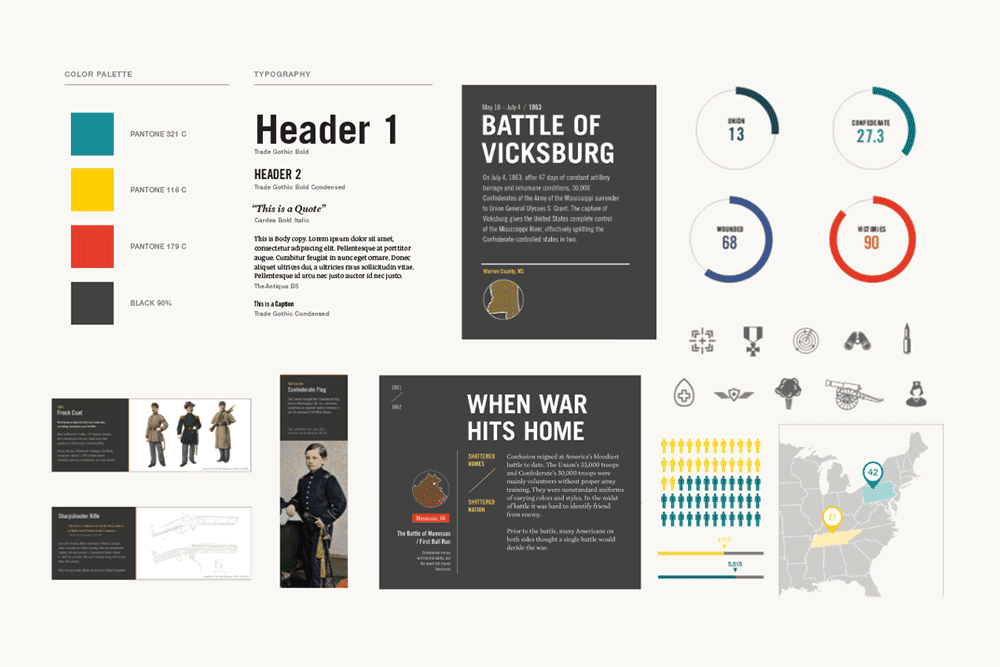American Civil War Museum
Broadening the perspective on the Civil War for a new generation
Client
Year
2019
Industry
History Museum, Education
My Role
Brand Designer
Environmental Designer
Interactive Designer
Project Overview
A People’s Contest is a groundbreaking exhibition at the American Civil War Museum, reinterpreting the Civil War through diverse and often overlooked perspectives. Under new leadership, the museum sought to move beyond traditional narratives, incorporating the voices of soldiers, enslaved and free African Americans, women, and civilians to present a fuller, more complex history.
Located in the newly built museum at Tredegar Ironworks in Richmond, VA, the exhibition is set against the backdrop of a historic Confederate munitions factory, reinforcing the war’s lasting impact. Through a mix of artifacts, interactive storytelling, and multimedia experiences, visitors engage with history in a personal and immersive way.
A key goal was to make Civil War history more accessible and engaging for younger audiences. The exhibit features hands-on interactives, digital media, and dynamic storytelling, encouraging visitors to explore the war’s complexities and its relevance today. By broadening perspectives and challenging long-held assumptions, A People’s Contest invites deeper reflection on America’s defining conflict.
Design Process
The design of A People’s Contest was driven by a structured, research-based approach to ensure an engaging and immersive visitor experience. My role spanned user journey mapping, emotional impact analysis, graphic system development, and artifact casework design, all aimed at creating a cohesive branded narrative and exhibition.
1. Mapping the Visitor Experience
To understand how visitors would engage with the content, we developed layered visitor journey maps that outlined the flow through the exhibit. I helped conduct research on the emotional impact of different stories and media—including interpretive panels, videos, audio, scenic environments, and digital interactives. Using this data, I created an emotional heat map, which visualized high- and low-intensity moments throughout the exhibit. This allowed us to strategically balance reflective, information-heavy sections with immersive, high-engagement moments, ensuring a dynamic and well-paced experience.
Thematic and Emotional Journey Map
2. Developing the Graphic System
I led the development and implementation of the visual design system, integrating it within the physical space and across digital touchpoints. The visual identity was designed to make historical content more accessible and engaging, particularly for younger audiences. Departing from the conventional war-themed palette, I introduced neutral cool tones to complement the warm hues of the artifacts, creating a modern and inviting atmosphere. Bold yellow accents highlighted key interpretive moments and enhanced wayfinding in the darker exhibit environment. To ensure clarity and maintain a neutral, factual tone, I selected Trade Gothic—a typeface originally designed for newspaper headlines—bringing a modern yet historically grounded structure to the exhibit’s storytelling.
Visual and Material Design System
3. Designing the Artifact Display & Casework System
The exhibit featured over 400 historical artifacts, necessitating a structured and accessible display system that balanced narrative clarity with visual cohesion. To achieve this, I developed detailed artifact placement diagrams, mapping out the exact positioning of each object, its accompanying description, and corresponding interpretive text and graphics. Beyond artifact arrangement, these diagrams played a key role in aligning the efforts of the content team, production designers, fabrication team, and installation crew. They facilitated efficient case assembly, ensuring that over 20 artifact cases were installed with both precision and interpretive clarity. The structured system streamlined workflow coordination, minimizing errors and allowing for real-time adjustments during installation.
Casework Planning and Realization







